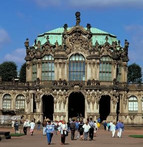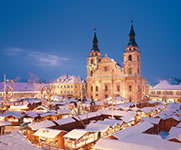Other highlights
Contact
Dresden - Werbung und Tourismus GmbH
Ostra Allee 11
01067 Dresden
Email:
info@dresden-tourist.de
Internet:
www.dresden-tourist.de
Ostra Allee 11
01067 Dresden
Email:
info@dresden-tourist.de
Internet:
www.dresden-tourist.de
Museums

The Green Vault, the former treasure chamber of the Wettin dynasty of Saxony, covers around 2,000m² of exhibition space. Every year, it dazzles thousands of visitors with its glittering collection of exquisitely crafted jewellery and gold. Wheelchair access, multilingual audio guides available. As the Green Vault only has capacity for 100 visitors per hour, tickets are valid for specific time slots only, and must be booked in advance. Closed on Tuesdays.
» Further information
This illuminating museum in Dresden unites five modes of transport under one roof, including exhibitions on railways and urban transport systems. Authentic exhibits, true-to-life models and informative displays provide a snapshot of motor vehicles and bicycles down the ages. The museum is closed on Mondays (except Easter Monday and Whitsun). General and themed guided tours are available to suit all ages. Please book in advance.
» Further information
The Old Masters Gallery in Dresden's Zwinger Palace holds one of the world's most important collections of European paintings, with more than 760 works on display, dating from around 1350 to 1800. This stunning gallery reflects the tastes of its most significant contributors, King August the Strong and King August II, who in the first half of the 18th century amassed a fine collection of artwork from the earlier Renaissance and baroque periods. Italian paintings from this era are a particular speciality, with major works by artists such as Raphael, Correggio, Giorgione and Titian. Equally significant is the work of 17th century Dutch and Flemish painters such as Rembrandt, Vermeer, Ruysdael, Rubens, Jordaens and Van Dyck. The gallery also displays works by Old German and Old Dutch masters, as well as important paintings by Spanish and French artists. Closed on Mondays, guided tours on request.
» www.skd-dresden.de
One of Dresden's oldest museums, the Coin Cabinet has its origins with George the Bearded, Duke of Saxony (1500-1539). Coins, medals and banknotes are important historical artefacts, and with approx. 300,000 objects, the Coin Cabinet ranks among the major universal collections in Europe. The collection includes coins from antiquity through the Middle Ages to the present day, medals from the 15th century to the modern age; banknotes and other paper securities from the last three centuries, military decorations, badges of honour, seals, seal imprints, dies and minting apparatus. Open from March to the beginning of November, closed on Tuesdays. Special guided tours on request.
» www.dresden-tourist.de
Founded in 1999, the Erich Kästner Museum is the world's first "mobile, interactive micro-museum". In an arrangement reminiscent of building blocks, 13 free-moving sections are arranged around a central spine. Every one is an exhibition in itself, with drawers, cabinets and compartments packed with exhibits that you can actually touch. The author's works are explored in a number of key themes, which provide an insight into his character and work. Categories include: "A German in Saxony", "A man between a rock and a hard place", "The reluctant outsider", "You must become as children", "Kästner's utopia" and "Kästner and the media". Open Sunday to Wednesday, Thursdays are reserved for groups, closed Friday to Saturday.
» www.erich-kaestner-museum.de
The State Natural History Collections in Dresden consist of the Museum of Mineralogy and Geology, the Zoology Museum and the Central Natural History Library, which became an independent specialist natural history museum in 1728. The museums have their origins in the Elector of Saxon's collections and are among the oldest geo-scientific establishments in the world. The collections include 6.5 million rocks, minerals and fossils from sites around Saxony. The museum's work is focused on mineralogy, petrography and paleontology. Closed on Mondays.
» www.smwk.de
The valuable cultural and historical Schwarzkopf collection has been on permanent loan to the German Hygiene Museum in Dresden since 1995. The fascinating collection about the history of beauty care and personal grooming has been assembled over a period of more than four decades. There are more than 2,000 exhibits in the collection, including antique razors and hairpins, bath and hairstyling accessories, wash bowls, dressing tables, powder boxes, flea traps, wig stands and equipment for curling and setting hair. They document the health care, beauty and grooming rituals from different cultural periods, from the ancient world to the Middle Ages, from the Renaissance, baroque and classicism periods to modern times. Closed on Mondays.
» www.dhmd.de
Dr Wolfgang Münchow (1923-1986), an ophthalmologist from Zwickau, donated his research collection on the history of ophthalmology to the German Hygiene Museum in Dresden in 1984. The collection comprises more than 1,000 exhibits from the 17th to the 20th centuries, including historical spectacles, diagnosis and examination equipment, surgical instruments, graphics and paintings and an extensive library on medical history. This collection traces not only the most important developments in the field of ophthalmology, but also the journalistic and cultural dimensions of this history. Closed on Mondays.
» www.dhmd.de
Opened in 1913, the Museum of Folk Art in Saxony is housed in Jägerhof Palace in Dresden Neustadt, just a stone's throw from the Elbe River. Spread across three floors, it gives a rich and varied insight into the region's customs and traditions. Items on display include: hand-crafted wooden furniture, metal-forged objects, tin castings, pottery, glass-blowing art, wood-turnings, carvings, miners' arts and crafts, lace and bobbin cloths from the Erzgebirge, traditional Sorbian costumes and Seiffen toys. The puppet theatre collection is one of the largest in the world, with over 50,000 exhibits from Europe and Asia. Exhibits range from 200-year-old marionettes and hand puppets used at local fairs, to characters used in Bauhaus theatre and modern-day figurative puppets. For a special treat, visit the museum's popular Christmas and Easter exhibitions. Closed on Mondays. Guided tours on request.
» www.skd-dresden.de
Elector August laid the foundation for Dresden's first collection in 1560, with his Electoral Art Chamber, and by the 17th century it had already become one of Europe's most famous attractions. The collection grew so quickly in terms of both size and scope that by the 18th century, special museums had to be set up.
Travel Planner
Select an option...
Map of Germany
Hotels in Dresden
Loading



